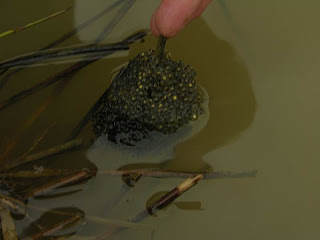There may not be a more familiar amphibian by sight than the homely American toad (
Bufo americanus). Easily identified by its stout body, warty skin with large parotoid glands on the rear of the head and speckled underside the American toad is a staple of vernal and ephemeral pools statewide. So adaptable is this amphibian that extensive surveying would probably reveal specimens from the majority of sections of each township in the watershed area.
The American toad has an advantage over other amphibians in its ability to adapt to a variety of environmental conditions such as increased pollution, development and agriculture. Adults often wander into suburbia and may breed in backyard birdbaths and ornamental watergardens as long as vehicle traffic (a major threat to migrating adults) is not too extensive. Adults usually emerge with the first 70+ degree weather of early April and chorus into mid-May. Male vocalizations are in the form of a high-pitched trill lasting 10-20 seconds and a shorter territorial chirping emitted between competing individuals in a pool. Large evening choruses are one of the most pleasant signs of spring in eastern Ohio. Eighty degree temperatures this past Sunday followed by a mild rainy Monday night brought out toads in large numbers. Look for chorusing males or strings of eggs in local vernal pools and roadside ditches. American toads seem to prefer (but are not limited to) similar habitat to mountain chorus frogs and wood frogs.
 |
American toads in amplexus. Fertilization of eggs occurs
externally. Males are generally smaller in size than females
and have enlarged thumbs on their forelimbs during the spring
for easier grasping. Eggs are deposited by females in long
strings and can number in the thousands in larger pools. |
 |
Males will aggressively compete for anything that resembles a
female in a pool, even a piece of carpet! The forelimb grip of
a male is surpisingly strong considering their size. As in wood
frogs coloration varies widely ranging from tan to olive to maroon. |
























